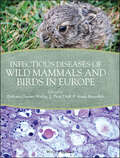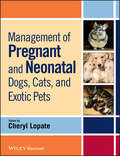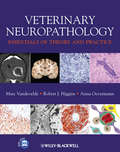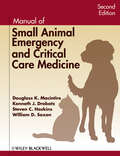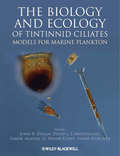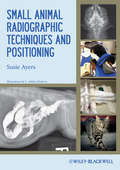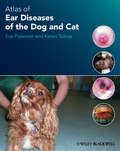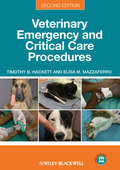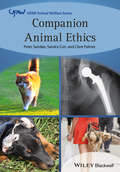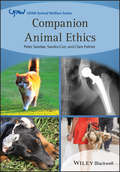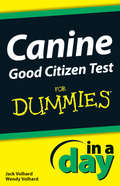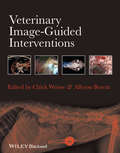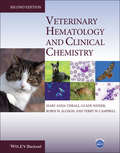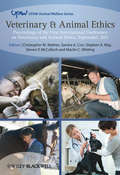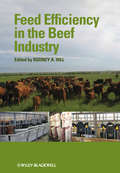- Table View
- List View
Infectious Diseases of Wild Mammals and Birds in Europe
by Dolores Gavier-Widen Anna Meredith J. Paul Duff Dolorés Gavier-WidenInfectious Diseases of Wild Mammals and Birds in Europe is a key resource on the diagnosis and treatment of infectious diseases in European wildlife that covers the distinctive nature of diseases as they occur in Europe, including strains, insect vectors, reservoir species, and climate, as well as geographical distribution of the diseases and European regulations for reporting, diagnosis and control. Divided into sections on viral infections, bacterial infections, fungal and yeast infections, and prion infections, this definitive reference provides valuable information on disease classification and properties, causative agents, epidemiology, pathogenesis, and implications for human, domestic and wild animal health. Key features: • Brings together extensive research from many different disciplines into one integrated and highly useful definitive reference. • Zoonotic risks to human health, as well as risks to pets and livestock are highlighted. • Each disease is covered separately with practical information on the animal species in which the disease has been recorded, clinical signs of the disease, diagnostic methods, and recommended treatments and vaccination. • Wildlife vaccination and disease surveillance techniques are described. • Examines factors important in the spread of disease such as changing climate, the movement of animals through trade, and relaxations in the control of wide animal populations.
Infectious Diseases of Wild Mammals and Birds in Europe
by Dolores Gavier-Widén J. Paul Duff Anna MeredithInfectious Diseases of Wild Mammals and Birds in Europe is a key resource on the diagnosis and treatment of infectious diseases in European wildlife that covers the distinctive nature of diseases as they occur in Europe, including strains, insect vectors, reservoir species, and climate, as well as geographical distribution of the diseases and European regulations for reporting, diagnosis and control. Divided into sections on viral infections, bacterial infections, fungal and yeast infections, and prion infections, this definitive reference provides valuable information on disease classification and properties, causative agents, epidemiology, pathogenesis, and implications for human, domestic and wild animal health. Key features: • Brings together extensive research from many different disciplines into one integrated and highly useful definitive reference. • Zoonotic risks to human health, as well as risks to pets and livestock are highlighted. • Each disease is covered separately with practical information on the animal species in which the disease has been recorded, clinical signs of the disease, diagnostic methods, and recommended treatments and vaccination. • Wildlife vaccination and disease surveillance techniques are described. • Examines factors important in the spread of disease such as changing climate, the movement of animals through trade, and relaxations in the control of wide animal populations.
Management of Pregnant and Neonatal Dogs, Cats, and Exotic Pets
by Cheryl LopateManagement of Pregnant and Neonatal Dogs, Cats, and Exotic Pets is a comprehensive yet practical reference on small animal neonatology. Covering reproductive physiology of pregnancy and parturition, normal neonatology, and neonatal disorders in dogs, cats, and small exotic mammals, the book gives special emphasis to fetal well-being, parturition, normal physical parameters, behavior, common disorders and defects, emergency care, and orphan management. Information on nutritional and environmental considerations for both the dam and offspring is included, as well as guidance on offering advice to breeders providing neonatal care at home. Well illustrated throughout, Management of Pregnant and Neonatal Dogs, Cats, and Exotic Pets is a complete resource for the successful management of pregnant and newborn pets. Veterinary practitioners, students, technicians, and professional breeders all will find the book’s how-to, clinically relevant approach to small animal neonatology invaluable.
Management of Pregnant and Neonatal Dogs, Cats, and Exotic Pets
by Cheryl LopateManagement of Pregnant and Neonatal Dogs, Cats, and Exotic Pets is a comprehensive yet practical reference on small animal neonatology. Covering reproductive physiology of pregnancy and parturition, normal neonatology, and neonatal disorders in dogs, cats, and small exotic mammals, the book gives special emphasis to fetal well-being, parturition, normal physical parameters, behavior, common disorders and defects, emergency care, and orphan management. Information on nutritional and environmental considerations for both the dam and offspring is included, as well as guidance on offering advice to breeders providing neonatal care at home. Well illustrated throughout, Management of Pregnant and Neonatal Dogs, Cats, and Exotic Pets is a complete resource for the successful management of pregnant and newborn pets. Veterinary practitioners, students, technicians, and professional breeders all will find the book’s how-to, clinically relevant approach to small animal neonatology invaluable.
Veterinary Neuropathology: Essentials of Theory and Practice
by Marc Vandevelde Robert Higgins Anna OevermannIntroducing the theoretical and practical basics of veterinary neuropathology, this concise and well illustrated book is an essential basic diagnostic guide for pathologists, neurologists and diagnostic imaging specialists. It presents readers with strategies to deal with neuropathological problems, showing how to interpret gross and histological lesions using a systematic approach based on pattern recognition. It starts with an overview of the general principles of neuroanatomy, neuropathological techniques, basic tissue reaction patterns, and recognition of major lesion patterns. The book goes on to cover vascular diseases, inflammatory diseases, trauma, congenital malformations, metabolic-toxic diseases, neoplasia and degenerative diseases mainly of the central nervous system. In the respective chapters pathologists can quickly find information to support their daily diagnostic workup for both small and large domestic species. Based on the authors’ extensive diagnostic and post graduate teaching experience as well as the inclusion of MRI as it relates to neuropathology, this book also offers a comprehensive but basic analysis of veterinary neuropathology that neurologists and other MRI users will find very useful. • An essential manual for daily diagnostic work • Richly illustrated with high quality colour gross, histological and MRI images • Includes a section on the function and use of MRI (by Johann Lang, DECVDI) • Accompanied by a website presenting MRI sequences for interpretation and correlation with neuropathological findings edited by Johann Lang (University of Bern, Switzerland) and Eric Wiesner (University of California, Davis, USA)
Manual of Small Animal Emergency and Critical Care Medicine
by Douglass K. Macintire Kenneth J. Drobatz Steven C. Haskins William D. SaxonManual of Small Animal Emergency and Critical Care Medicine, Second Edition presents essential information on common emergencies in small animals using a concise, practical outline format. Offering a thorough update to this classic reference, the new edition provides new chapters on orthopedic injuries and wound management, significant revisions to the treatment protocols, and expanded toxicology information, as well as new references and drug information. The book retains its logical division into two parts, the first covering initial stabilization and the second offering a systems approach to specific conditions. As in the previous edition, chapters are extensively indexed and cross-referenced to facilitate ease of use in emergency situations. With many formulas, tables, drug dosages, and illustrations, Manual of Small Animal Emergency and Critical Care Medicine is an indispensable, convenient resource for busy emergency clinicians, whether they are new graduates or seasoned professionals.
Manual of Small Animal Emergency and Critical Care Medicine
by Douglass K. Macintire Kenneth J. Drobatz Steven C. Haskins William D. SaxonManual of Small Animal Emergency and Critical Care Medicine, Second Edition presents essential information on common emergencies in small animals using a concise, practical outline format. Offering a thorough update to this classic reference, the new edition provides new chapters on orthopedic injuries and wound management, significant revisions to the treatment protocols, and expanded toxicology information, as well as new references and drug information. The book retains its logical division into two parts, the first covering initial stabilization and the second offering a systems approach to specific conditions. As in the previous edition, chapters are extensively indexed and cross-referenced to facilitate ease of use in emergency situations. With many formulas, tables, drug dosages, and illustrations, Manual of Small Animal Emergency and Critical Care Medicine is an indispensable, convenient resource for busy emergency clinicians, whether they are new graduates or seasoned professionals.
The Biology and Ecology of Tintinnid Ciliates: Models for Marine Plankton
by John R. Dolan David J. S. Montagnes Sabine Agatha D. Wayne Coats Diane K. StoeckerPlanktonic protists both produce and consume most of the primary production in the world ocean. They not only play key roles in the oceans but also represent an astounding amount of diversity: ecological morphological and genetic. However, for most taxa their ecology, morphology, phylogeny and biogeography are either poorly known or appear to be largely unrelated to one another; this hinders our understanding of their biology as well as interpretation of emerging genetic data. Tintinnid ciliates represent a singular exception. Compared to nearly all other groups of planktonic protists, there is a very substantial and relatively detailed literature (both modern and historical) on tintinnids. This volume synthesizes knowledge concerning a wide variety of topics ranging from anatomy and systematics, physiology, behavior, ecology (including ecological roles, predators, parasites, biogeography, and cysts) to fossil history. It will appeal to an audience ranging from advanced undergraduates to researchers in the fields of Oceanography, Marine Biology and Microbial Ecology.
The Biology and Ecology of Tintinnid Ciliates: Models for Marine Plankton
by John R. Dolan David J. S. Montagnes Sabine Agatha D. Wayne Coats Diane K. StoeckerPlanktonic protists both produce and consume most of the primary production in the world ocean. They not only play key roles in the oceans but also represent an astounding amount of diversity: ecological morphological and genetic. However, for most taxa their ecology, morphology, phylogeny and biogeography are either poorly known or appear to be largely unrelated to one another; this hinders our understanding of their biology as well as interpretation of emerging genetic data. Tintinnid ciliates represent a singular exception. Compared to nearly all other groups of planktonic protists, there is a very substantial and relatively detailed literature (both modern and historical) on tintinnids. This volume synthesizes knowledge concerning a wide variety of topics ranging from anatomy and systematics, physiology, behavior, ecology (including ecological roles, predators, parasites, biogeography, and cysts) to fossil history. It will appeal to an audience ranging from advanced undergraduates to researchers in the fields of Oceanography, Marine Biology and Microbial Ecology.
Small Animal Radiographic Techniques and Positioning
by Susie AyersSmall Animal Radiographic Techniques and Positioning is a practical, clinically applicable manual designed to aid veterinary technicians and nurses in correcting common artifacts in both film and digital radiography and in positioning the small animal patient for clear and consistent radiographs. Detailed positioning techniques are provided for each commonly radiographed body segment, including positioning aids, alternative restraint methods, and examples of the corresponding correct or incorrect radiographs. Species covered include dogs, cats, birds, and common exotics. The book begins with an overview of radiographic technique, darkroom maintenance, digital and film-screen imaging, then offers a section on small animal positioning, including some exotic species positioning techniques, with the final section presenting information on contrast media and special contrast enhanced procedures. A companion website provides the images from the book in PowerPoint and study questions and answers at www.wiley.com/go/ayers. Highly illustrated, Small Animal Radiographic Techniques and Positioning is a complete resource for any veterinary technician or student to quickly find imaging information and improve the clarity of small animal radiographs.
Small Animal Radiographic Techniques and Positioning
by Susie AyersSmall Animal Radiographic Techniques and Positioning is a practical, clinically applicable manual designed to aid veterinary technicians and nurses in correcting common artifacts in both film and digital radiography and in positioning the small animal patient for clear and consistent radiographs. Detailed positioning techniques are provided for each commonly radiographed body segment, including positioning aids, alternative restraint methods, and examples of the corresponding correct or incorrect radiographs. Species covered include dogs, cats, birds, and common exotics. The book begins with an overview of radiographic technique, darkroom maintenance, digital and film-screen imaging, then offers a section on small animal positioning, including some exotic species positioning techniques, with the final section presenting information on contrast media and special contrast enhanced procedures. A companion website provides the images from the book in PowerPoint and study questions and answers at www.wiley.com/go/ayers. Highly illustrated, Small Animal Radiographic Techniques and Positioning is a complete resource for any veterinary technician or student to quickly find imaging information and improve the clarity of small animal radiographs.
Atlas of Ear Diseases of the Dog and Cat
by Sue Paterson Karen TobiasBringing together a wealth of images of normal and diseased dog and cat ears, this is an indispensible diagnostic tool for the small animal veterinary practitioner seeing ear cases on a regular basis. This fully illustrated atlas covers the anatomy of the canine and feline ear, diagnostic techniques, a range of commonly seen diseases, and ear surgery. Atlas of Ear Diseases of the Dog and Cat is one of the most complete picture references for this rapidly expanding branch of small animal medicine and surgery. It is an invaluable aid for general practitioners, as well as those specialising in dermatology, and serves as an effective revision aid for veterinary students and those studying for further qualifications in veterinary dermatology. Includes over 400 high quality colour clinical images and clear line drawings Images are accompanied by clear explanatory text throughout Enables veterinarians to match cases seen in practice with photos supplied to aid diagnosis Written by highly qualified specialist veterinary dermatologist and veterinary surgeon
Atlas of Ear Diseases of the Dog and Cat
by Sue Paterson Karen TobiasBringing together a wealth of images of normal and diseased dog and cat ears, this is an indispensible diagnostic tool for the small animal veterinary practitioner seeing ear cases on a regular basis. This fully illustrated atlas covers the anatomy of the canine and feline ear, diagnostic techniques, a range of commonly seen diseases, and ear surgery. Atlas of Ear Diseases of the Dog and Cat is one of the most complete picture references for this rapidly expanding branch of small animal medicine and surgery. It is an invaluable aid for general practitioners, as well as those specialising in dermatology, and serves as an effective revision aid for veterinary students and those studying for further qualifications in veterinary dermatology. Includes over 400 high quality colour clinical images and clear line drawings Images are accompanied by clear explanatory text throughout Enables veterinarians to match cases seen in practice with photos supplied to aid diagnosis Written by highly qualified specialist veterinary dermatologist and veterinary surgeon
Veterinary Emergency and Critical Care Procedures
by Timothy B. Hackett Elisa M. MazzaferroVeterinary Emergency and Critical Care Procedures, Second Edition is a step-by-step guide to key emergency and critical care procedures encountered in both general and specialty practice. Now in full color, the second edition includes several new procedures, two new chapters covering cardiopulmonary resuscitation and continuous rate infusions, and a companion website offering videos demonstrating most of the procedures featured in the book. Helpful hints have also been added throughout to make the book even more useful in the practice setting. Each procedure includes information on the background, supplies needed, indications, and contraindications, followed by a series of images demonstrating the technique. This practical resource, ideally designed for use in fast-paced emergency situations, is an indispensable reference for any member of the veterinary team.
Veterinary Emergency and Critical Care Procedures, Enhanced Edition
by Timothy B. Hackett Elisa M. MazzaferroVeterinary Emergency and Critical Care Procedures, Second Edition is a step-by-step guide to key emergency and critical care procedures encountered in both general and specialty practice. Now in full color, the second edition includes several new procedures, two new chapters covering cardiopulmonary resuscitation and continuous rate infusions, and a companion website offering videos demonstrating most of the procedures featured in the book. Helpful hints have also been added throughout to make the book even more useful in the practice setting. Each procedure includes information on the background, supplies needed, indications, and contraindications, followed by a series of images demonstrating the technique. This practical resource, ideally designed for use in fast-paced emergency situations, is an indispensable reference for any member of the veterinary team.
Companion Animal Ethics (UFAW Animal Welfare)
by Peter Sandøe Sandra Corr Clare PalmerCompanion Animal Ethics explores the important ethical questions and problems that arise as a result of humans keeping animals as companions. The first comprehensive book dedicated to ethical and welfare concerns surrounding companion animals Scholarly but still written in an accessible and engaging style Considers the idea of animal companionship and why it should matter ethically Explores problems associated with animals sharing human lifestyles and homes, such as obesity, behavior issues, selective breeding, over-treatment, abandonment, euthanasia and environmental impacts Offers insights into practical ways of improving ethical standards relating to animal companions
Companion Animal Ethics (UFAW Animal Welfare)
by Peter Sandøe Sandra Corr Clare PalmerCompanion Animal Ethics explores the important ethical questions and problems that arise as a result of humans keeping animals as companions. The first comprehensive book dedicated to ethical and welfare concerns surrounding companion animals Scholarly but still written in an accessible and engaging style Considers the idea of animal companionship and why it should matter ethically Explores problems associated with animals sharing human lifestyles and homes, such as obesity, behavior issues, selective breeding, over-treatment, abandonment, euthanasia and environmental impacts Offers insights into practical ways of improving ethical standards relating to animal companions
Canine Good Citizen Test In A Day For Dummies (In A Day For Dummies)
by Jack Volhard Wendy VolhardHelp your four-legged friend pass the Canine Good Citizen Test in a day? Easy! The AKC's Canine Good Citizen (CGC) Program is one of the most rapidly growing programs in the American Kennel Club. With useful tips and quick fixes that will put a stop to all sorts of bad habits, Canine Good Citizen Test In A Day For Dummies helps owners build solid relationships with their dog based on positive reinforcement, trust, and obedience. This handy little guide gives you a better understanding of the test itself, the essential skills tested, and the benefits of this unique training program. It covers the test's requirements and various elements, and is packed with expert tips and advice for mastering all ten sections of the test. A detailed description of the entire test's requirements and elements Tips and tricks for mastering each the of 10 sections of the test The do's and don'ts of taking the test Online component takes you beyond the book with bonus content and features Canine Good Citizen Test In A Day For Dummies gives you everything you need to help your dog master the skills and proficiencies necessary to pass the AKC's Good Canine Test.
Canine Good Citizen Test In A Day For Dummies (In A Day For Dummies)
by Jack Volhard Wendy VolhardHelp your four-legged friend pass the Canine Good Citizen Test in a day? Easy! The AKC's Canine Good Citizen (CGC) Program is one of the most rapidly growing programs in the American Kennel Club. With useful tips and quick fixes that will put a stop to all sorts of bad habits, Canine Good Citizen Test In A Day For Dummies helps owners build solid relationships with their dog based on positive reinforcement, trust, and obedience. This handy little guide gives you a better understanding of the test itself, the essential skills tested, and the benefits of this unique training program. It covers the test's requirements and various elements, and is packed with expert tips and advice for mastering all ten sections of the test. A detailed description of the entire test's requirements and elements Tips and tricks for mastering each the of 10 sections of the test The do's and don'ts of taking the test Online component takes you beyond the book with bonus content and features Canine Good Citizen Test In A Day For Dummies gives you everything you need to help your dog master the skills and proficiencies necessary to pass the AKC's Good Canine Test.
Veterinary Image-Guided Interventions
by Chick Weisse Allyson BerentVeterinary Image-Guided Interventions is the only book dedicated to interventions guided by imaging technology. Written and edited by leading experts in the field, interventional endoscopy, cardiology, oncology and radiology are covered in detail. Chapters include the history and background of the procedures, patient work-up, equipment lists, detailed procedural instructions, potential complications, patient follow-up protocols, and expected outcomes. Split into body systems, the technical aspects of each procedure are presented using highly illustrated step-by-step guides. Veterinary Image-Guided Interventions is a must-have handbook for internists, surgeons, cardiologists, radiologists, oncologists and criticalists, and for anyone interested in cutting-edge developments in veterinary medicine. Key features include: A highly practical step-by-step guide to image-guided procedures Relevant to a wide range of veterinary specialists. Written and edited by respected pioneers in veterinary image-guided procedures A companion website offers videos of many procedures to enhance the text
Veterinary Image-Guided Interventions
by Chick Weisse Allyson BerentVeterinary Image-Guided Interventions is the only book dedicated to interventions guided by imaging technology. Written and edited by leading experts in the field, interventional endoscopy, cardiology, oncology and radiology are covered in detail. Chapters include the history and background of the procedures, patient work-up, equipment lists, detailed procedural instructions, potential complications, patient follow-up protocols, and expected outcomes. Split into body systems, the technical aspects of each procedure are presented using highly illustrated step-by-step guides. Veterinary Image-Guided Interventions is a must-have handbook for internists, surgeons, cardiologists, radiologists, oncologists and criticalists, and for anyone interested in cutting-edge developments in veterinary medicine. Key features include: A highly practical step-by-step guide to image-guided procedures Relevant to a wide range of veterinary specialists. Written and edited by respected pioneers in veterinary image-guided procedures A companion website offers videos of many procedures to enhance the text
Veterinary Hematology and Clinical Chemistry
by Mary Anna Thrall Glade Weiser Terry W. Campbell Robin AllisonVeterinary Hematology and Clinical Chemistry, Second Edition is a well-illustrated, user-friendly reference on veterinary laboratory diagnostic techniques and interpretation. Covering both hematology and chemistry for a wide range of species, including birds, reptiles, amphibians, and fish, the book provides an overview of these critical veterinary skills. This Second Edition includes many revisions and additions, including new chapters on molecular diagnostics of hematologic malignancies and lipid pathology, updates to reflect advances in diagnostic instrumentation and capabilities, significant revisions to the data interpretation chapter to provide introductory guidance, and current information on immunodiagnostics and laboratory diagnostics of renal, endocrine, and calcium metabolic pathologies. Beginning with the basic principles of laboratory testing and diagnosis, the book moves into in-depth information on hematology and chemistry of common domestic and non-domestic species. Clinical case presentations, supplying case data and offering narrative discussions to promote skills, have been expanded and incorporated into the body of the book. Packed with useful information for veterinary students, technicians, pathologists, and researchers, Veterinary Hematology and Clinical Chemistry is an essential addition to any veterinary library.
Veterinary Hematology and Clinical Chemistry
by Mary Anna Thrall Glade Weiser Terry W. Campbell Robin W. AllisonVeterinary Hematology and Clinical Chemistry, Second Edition is a well-illustrated, user-friendly reference on veterinary laboratory diagnostic techniques and interpretation. Covering both hematology and chemistry for a wide range of species, including birds, reptiles, amphibians, and fish, the book provides an overview of these critical veterinary skills. This Second Edition includes many revisions and additions, including new chapters on molecular diagnostics of hematologic malignancies and lipid pathology, updates to reflect advances in diagnostic instrumentation and capabilities, significant revisions to the data interpretation chapter to provide introductory guidance, and current information on immunodiagnostics and laboratory diagnostics of renal, endocrine, and calcium metabolic pathologies. Beginning with the basic principles of laboratory testing and diagnosis, the book moves into in-depth information on hematology and chemistry of common domestic and non-domestic species. Clinical case presentations, supplying case data and offering narrative discussions to promote skills, have been expanded and incorporated into the body of the book. Packed with useful information for veterinary students, technicians, pathologists, and researchers, Veterinary Hematology and Clinical Chemistry is an essential addition to any veterinary library.
Veterinary and Animal Ethics: Proceedings of the First International Conference on Veterinary and Animal Ethics, September 2011 (UFAW Animal Welfare)
by Christopher M. WathesThe first International Conference on Veterinary and Animal Ethics (ICVAE) held in September 2011 saw leading experts from across the world come together to discuss the most important issues of animal welfare in contemporary veterinary practice and research. This is the extended proceedings of that conference, enabling all those interested in this increasingly significant subject to benefit from the insights of those discussions. The conference was divided into four sessions: Principles of veterinary and animal ethics; Justifying ends - the morality of animal use; Ethical analyses of animal use; and Cultural, political, legal and economic considerations. Each session contained four or five papers, and these are presented here in full, as well as the transcribed question and answer sessions at the end of each paper, and a short post-presentation reflection from each author. Also included is the debate on the motion ‘Is it better to have lived and lost than never to have lived at all?’ which records three prepared responses to the question as well as registrants’ comments from the floor. KEY FEATURES • Contributions from the leading thinkers in veterinary and animal ethics today • Includes stimulating, challenging, thought-provoking and sometimes controversial discussions • Addresses key questions on the role of the veterinarian and the morality of animal use, as well as our impact on wildlife • Provides guidance on the practical application of ethical principles and the problems encountered Published as part of the UFAW Animal Welfare book series. See www.wiley.com/go/ufaw for more details.
Feed Efficiency in the Beef Industry
by Rodney A. HillFeed Efficiency in the Beef Industry provides a thorough and concise overview of feed efficiency in beef cattle. It frames the great importance of feed efficiency to the industry and details the latest findings of the many scientific disciplines that intersect and aim to improve efficient and sustainable production of nutritious beef. The vast majority of production costs are directly tied to feed. With increased demand for grains to feed a rapidly increasing world population and to supply a new demand for alternative fuels, feed costs continue to increase. In recent years, the negative environmental impacts of inefficient feeding have also been realized; as such feed efficiency is an important factor in both economic viability and environmental sustainability of cattle production. Feed Efficiency in the Beef Industry covers a broad range of topics ranging from economic evaluation of feed efficiency to the physiological and genetic bases of efficient conversion of feed to high quality beef. Chapters also look at how a fuller understanding of feed efficiency is leading to new selective breeding efforts to develop more efficient cattle. With wide-ranging coverage from leading international researchers, Feed Efficiency will be a valuable resource for producers who wish to understand the complexities, challenges, and opportunities to reduce their cost of production, for students studying the topic and for researchers and professionals working in the beef industry.
